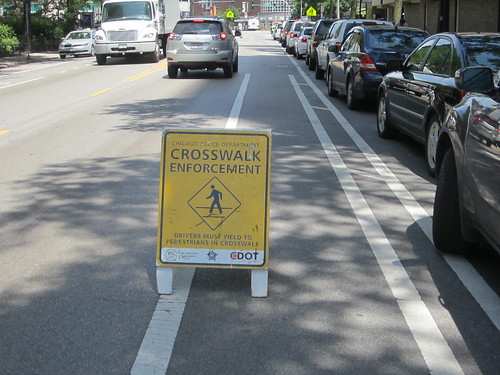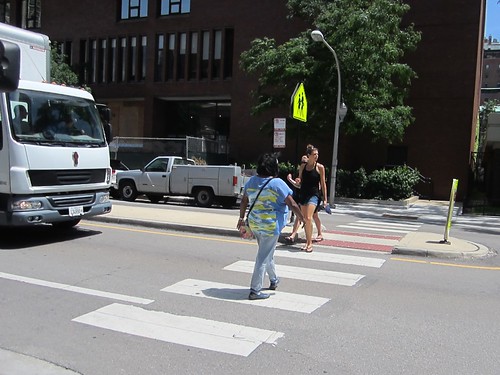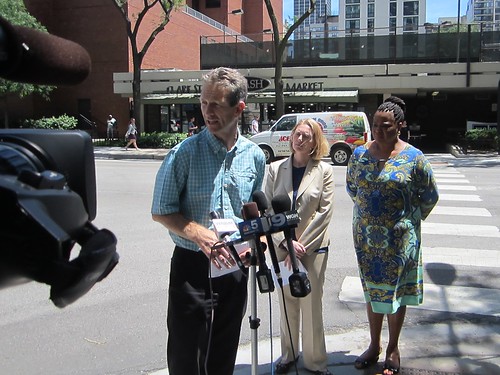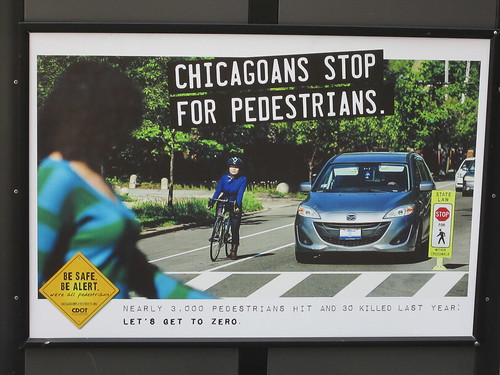You might have noticed many square, black bases bolted in the center of Chicago streets, which held “Stop for Pedestrians” signs before they were taken out by motorists. These testify to the fact that many local drivers don’t operate safely around crosswalks.
In an attempt to change that behavior, the Chicago Department of Transportation and the Chicago Police Department once again launched a pedestrian safety campaign, including crosswalk stings and ads reminding drivers to stop for people in crosswalks. As part of last year’s campaign, the police department wrote more than 1,200 tickets to motorists who failed to stop, resulting in $120 fines.
Earlier today, the city held a press conference at Clark Street and Germania Place in Old Town, where the police were conducting a sting. There’s a pedestrian island here, with chunks of concrete missing due to careless drivers, and “Stop for Pedestrians” signs were installed a while ago at crosswalks on the north and south legs of the intersection. Signs further north and south of the intersection warned drivers of the crosswalk enforcement event. Unfortunately, one of them was partially blocking the bike lane on Clark.

Plain-clothes police officers repeatedly crossed the street, while another officer in a squad car stood by, waiting to chase down drivers who failed to yield. In general, motorists were stopping when pedestrians were in the crosswalk, and sometimes even when the crosswalk was empty. Occasionally, the cop in the car would zoom out of his spot with lights and siren on to ticket an offender.
A nearby resident I spoke to said that drivers are generally pretty good about yielding to people on foot at this location. However, CDOT Commissioner Rebekah Scheinfeld said this intersection was chosen for the sting because there have been some crashes here. Similar “crosswalk awareness initiatives” are planned citywide at 60 crossings near schools, senior housing and business strips. The program is funded by a grant from the Illinois Department of Transportation.
“On average, roughly 3,000 pedestrians are hit by motor vehicle [drivers] every year in Chicago, resulting in an average of 30 deaths per year,” Scheinfeld told reporters. “This is unacceptable. Our goal is to reduce serious pedestrian injuries by 50 percent over the next five years, and to eliminate pedestrian fatalities within ten years.”
Scheinfeld cited CDOT safety initiatives like bumpouts, speed humps, and countdown walk signals as part of that effort, along with the Safe Routes Ambassadors program, which educates school children about safe walking and biking. 800 “Stop for Pedestrians” PSAs are going up on CTA buses, 100 are being installed in bus shelter posters, 50 are being displayed on news racks, and 40 are going up on solar garbage compactors. Notably, each ad includes an image of a bicyclist, which implies that lawbreaking behavior by bicyclists is a comparable threat to pedestrians as dangerous driving, when that’s obviously not the case.
Active Transportation Alliance director Ron Burke noted that nearly one out of every three traffic fatalities in Chicago is somebody on foot. “Every day, there are about seven or eight traffic-related pedestrian injuries in the city of Chicago, and that’s too many,” he said. “We can do much better. About 13 percent of all trips in Chicago are on foot. We need to move beyond the legacy of designing streets to move as many cars as fast as possible.” He asked reporters to inform the public that the law requiring motorists to stop for people in the crosswalk applies to all crosswalks, not just ones with "Stop for pedestrians" signs.
I asked Scheinfeld if CDOT has any strategies to keep the “Stop for Pedestrians” signs from being taken out so quickly by reckless drivers. She said the department does survey the locations carefully before installing the signs, to make sure there will be appropriate turning radiuses for cars. “But the fact that they are being hit is evidence that we have a problem with speeding, and that [drivers] are not going slow enough to be able to judge their distances from the signs,” she said. “In some ways, this brings attention to the very issue that we are trying to bring attention to.”
She added that aldermen are often open to using their discretionary funds to replace the signs, which cost $400 each installed, as of 2012. “They hear from their constituents that it is raising awareness, and communities are asking for these,” she said. “People feel safer with them and they’re seeing changes in motorists’ behavior.”







